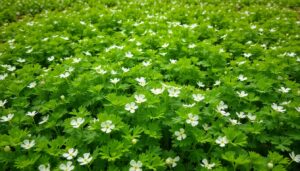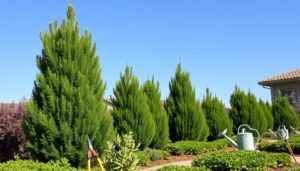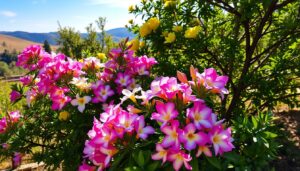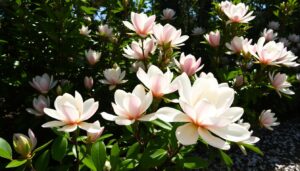What is the Landscaping Uses for a Spirea? Looking for a shrub to make your garden pop? Spirea might be the answer. These versatile plants are perfect for gardeners wanting beauty without the hassle.
Spirea is a favorite in landscaping for its adaptability. They look great in any yard, adding beauty with little work. Check out the uses of spirea in landscaping to see their full potential.
Spirea shrubs are known for their bright flowers and tough nature. They bring color, texture, and structure to your garden easily. They’re a great choice for any gardener.
Learn how spirea can take your garden to the next level. They’re perfect for making your outdoor space stand out. Dive into the world of spirea and see how they can transform your garden.
Table of Contents
What is Spirea?
Spirea is a versatile and charming shrub that can make your garden stand out. It’s native to temperate regions of the Northern Hemisphere. This deciduous plant belongs to the Rosaceae family and offers gardeners incredible design flexibility.
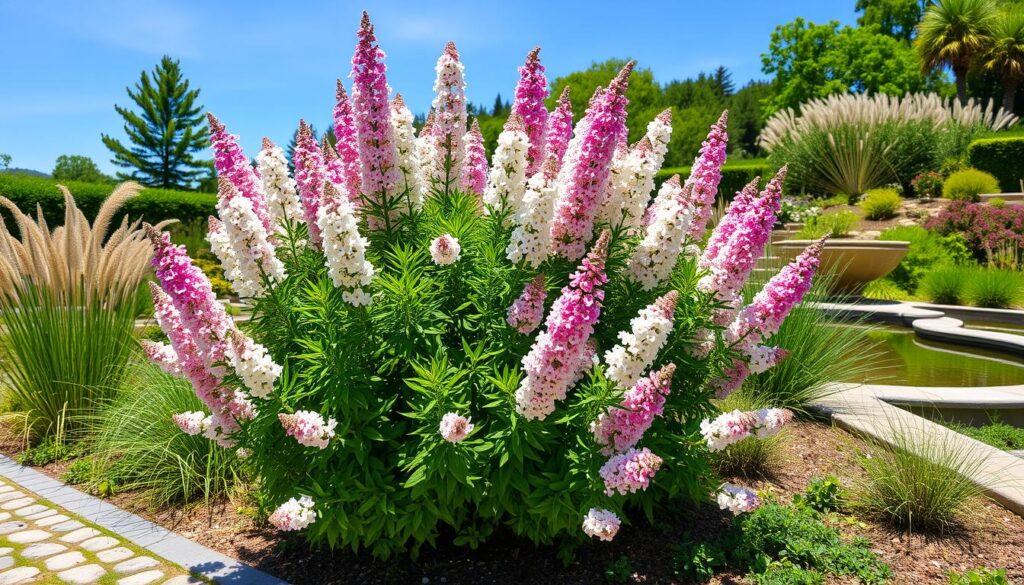
Gardeners love spirea for its unique features. These compact shrubs have delicate clusters of flowers. They create stunning visual displays in spring and summer.
Overview of Spirea
Spirea, also known as meadowsweet, is a botanical treasure. These resilient shrubs come in various sizes and shapes. They are adaptable to many landscape settings.
- Typically deciduous shrubs
- Flower colors range from white to pink and purple
- Compact growth habit
- Blooms appearing in spring and summer
Common Types of Spirea
When exploring spirea plant landscaping ideas, you’ll find several popular varieties:
- Japanese Spirea (Spiraea japonica)
- Bridal Wreath Spirea
- Anthony Waterer Spirea
- Bumald Spirea
Growth Habit and Size
Spirea shrubs come in a range of sizes and forms. Most varieties are between 2 to 6 feet tall. They fit well in various garden spaces because of their compact nature.
“A well-placed spirea can transform an ordinary landscape into a botanical masterpiece.” – Garden Design Expert
Knowing these characteristics helps you pick the right spirea for your garden.
Benefits of Using Spirea in Landscaping
Spirea is a great choice for gardeners who want beauty and practicality. These versatile shrubs are perfect for landscape design lovers.
Aesthetic Appeal That Transforms Gardens
Spirea makes your landscape come alive with its beauty. These shrubs add magic to garden designs with:
- Delicate clusters of flowers in white, pink, and purple hues
- Compact and graceful growth habit
- Seasonal color variations that add visual interest
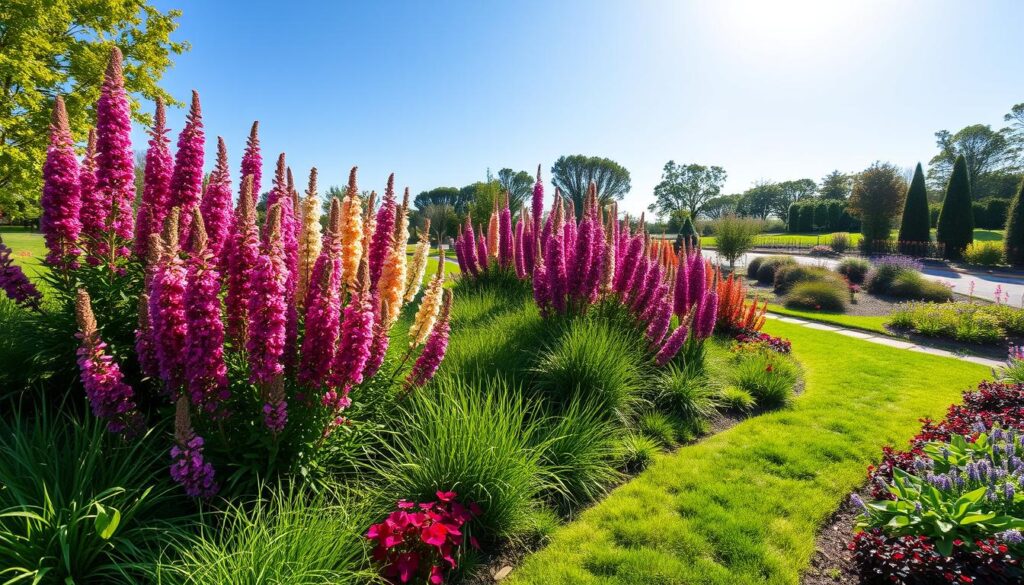
Low Maintenance Gardening Delight
Spirea is easy to care for, making it ideal for busy gardeners. These shrubs offer beautiful results with little effort.
| Care Aspect | Spirea Advantage |
|---|---|
| Watering | Drought-tolerant once established |
| Pruning | Minimal pruning required |
| Soil Adaptability | Thrives in various soil conditions |
Versatility in Garden Design
Spirea is incredibly versatile in outdoor design. They fit well in both formal and naturalistic gardens.
*”Spirea transforms gardens with its elegant simplicity and effortless charm.”*
Spirea can be used in many ways, from border plantings to standalone features. Their compact size and variety make them perfect for any landscape design.
Popular Varieties of Spirea for Landscaping
When adding spirea to your garden, you have many beautiful options. Each variety has its own special traits. They can make your outdoor areas look stunning with their leaves and flowers.
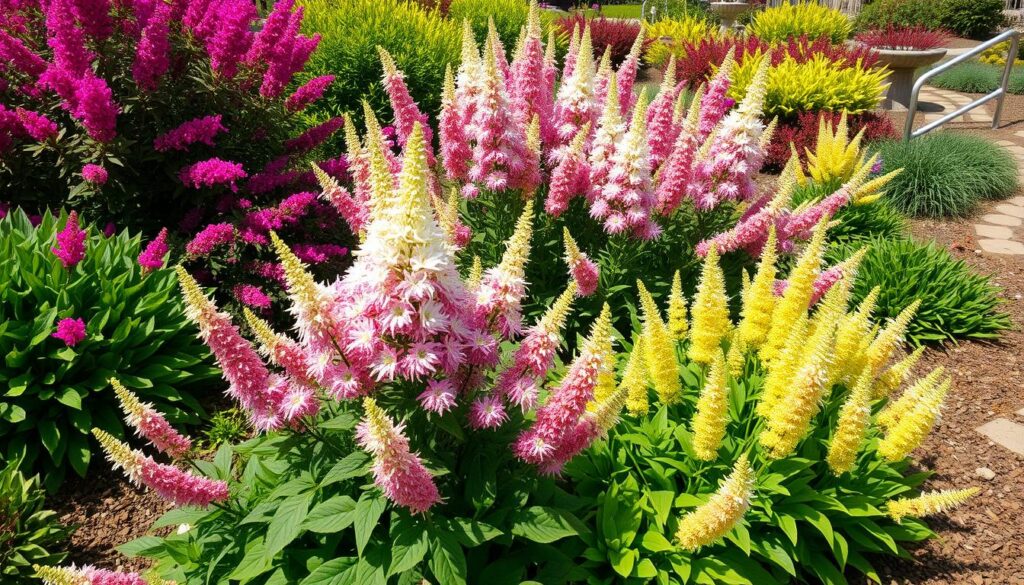
Spiraea japonica (Japanese Spirea)
Japanese spirea is a great choice for gardens. It’s a small shrub that grows 2-3 feet tall. It blooms with pink or white flowers, making it a favorite for many gardeners.
- Compact growth habit
- Colorful summer blooms
- Ability to thrive in various soil conditions
Spiraea alba (Meadowsweet)
Meadowsweet adds a natural touch to gardens. Spiraea alba has white flowers that attract bees and butterflies. It grows tall and straight, adding height to your garden.
Spiraea bumalda (Bumald Spirea)
Bumald spirea is a colorful and compact choice. It has:
- Compact size (2-3 feet tall)
- Attractive foliage with bronze-red new growth
- Clusters of pink or red flowers
“Spirea varieties offer gardeners incredible flexibility in landscape design,” says landscape architect Emily Rodriguez.
Designing With Spirea in Garden Layouts
Spirea is a versatile choice for gardeners. These shrubs can change your outdoor areas with their unique looks and beauty. Knowing how to use spirea in landscaping can make your garden stunning.
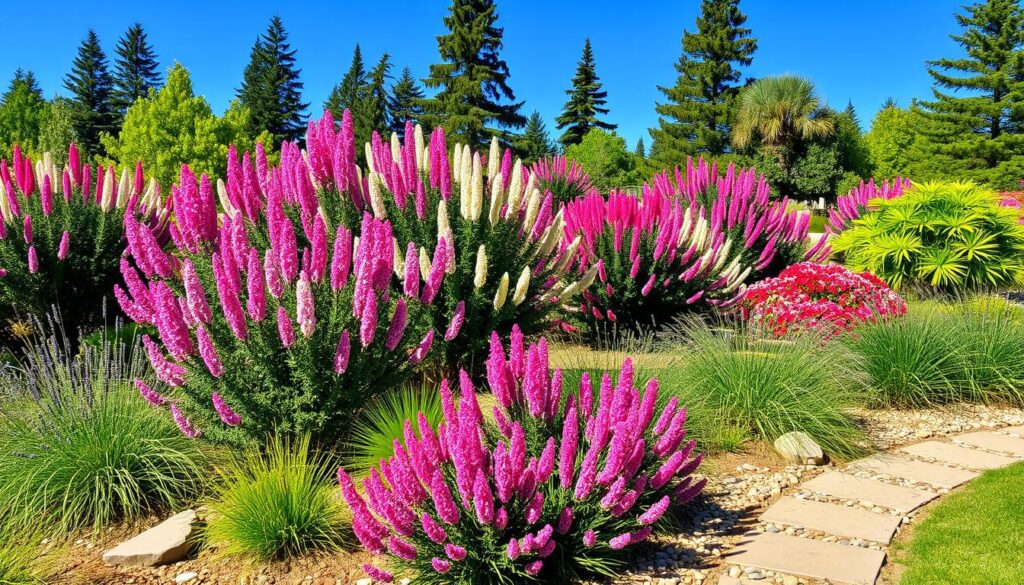
Incorporating Spirea in Borders
Spirea is great for garden borders. They grow compactly and bloom brightly, making them ideal for clear garden edges. Place spirea to add depth and interest to your garden landscaping.
- Create layered border designs
- Mix with perennials for color variation
- Use as natural garden dividers
Group Planting Techniques
Spirea looks amazing in groups. Mass plantings make a big impact, especially with different bloom times and foliage colors.
| Planting Technique | Visual Impact |
|---|---|
| Drift Plantings | Soft, naturalistic appearance |
| Geometric Clusters | Modern, structured look |
| Mixed Height Groupings | Dynamic, multi-dimensional design |
Using Spirea as Ground Cover
Low-growing spirea varieties are great for ground cover. Spiraea japonica cultivars, for example, fill spaces well. They prevent soil erosion and stop weeds.
“Spirea transforms ordinary landscapes into extraordinary garden experiences.” – Garden Design Expert
Seasonal Interest Offered by Spirea
Spirea shrubs are more than just a one-season wonder. They are a key part of any dynamic garden. These plants change your garden from spring to winter, keeping it interesting all year.
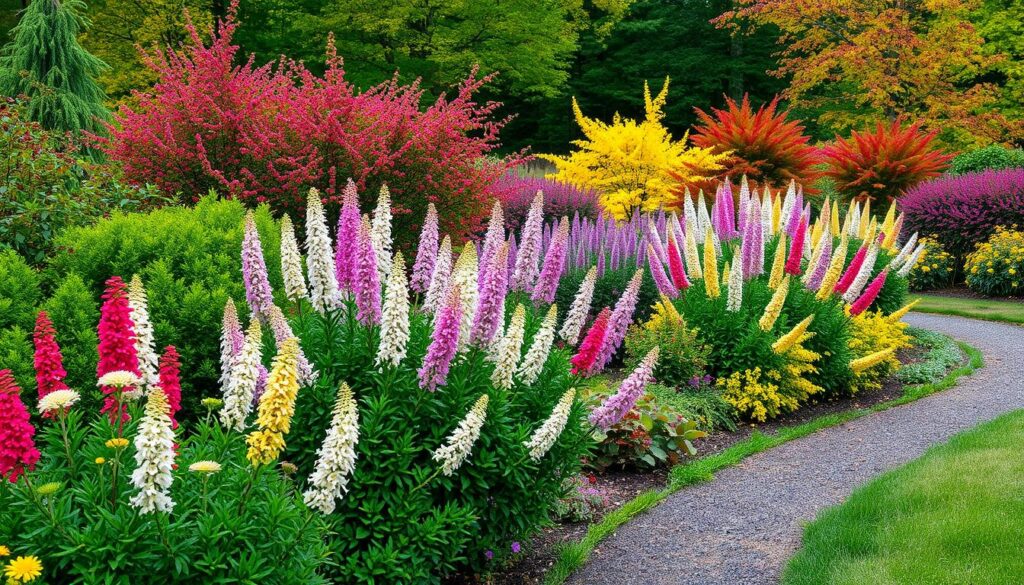
For gardeners looking for a plant that’s always in style, spirea is perfect. It keeps your garden exciting all year, making it a top pick for designers.
Spring Blooms: A Spectacular Display
In spring, spirea comes alive with beautiful flowers. These flowers create a stunning view. They come in:
- Soft pink hues
- Pristine white clusters
- Vibrant pastel shades
Fall Foliage Colors: Autumn Brilliance
When summer ends, spirea changes again. Its leaves turn into amazing autumn colors. You’ll see everything from golden yellows to deep burgundy. This adds beauty and depth to your garden.
All-Weather Resilience
Spirea is incredibly tough, handling all kinds of weather. Even in winter, its strong structure keeps your garden looking good.
| Season | Landscape Contribution |
|---|---|
| Spring | Abundant flower clusters |
| Summer | Lush green foliage |
| Fall | Dramatic color changes |
| Winter | Structural branch interest |
“A garden with spirea is a garden with perpetual beauty.” – Landscape Design Expert
Adding spirea to your garden means you’ll have beauty all year. It’s a smart and beautiful choice for your garden.
Attracting Wildlife with Spirea
Spirea turns your garden into a lively ecosystem that supports local wildlife. These shrubs are more than pretty plants. They’re vital homes for pollinators and small animals. By adding spirea to your garden, you make a place full of life and energy.
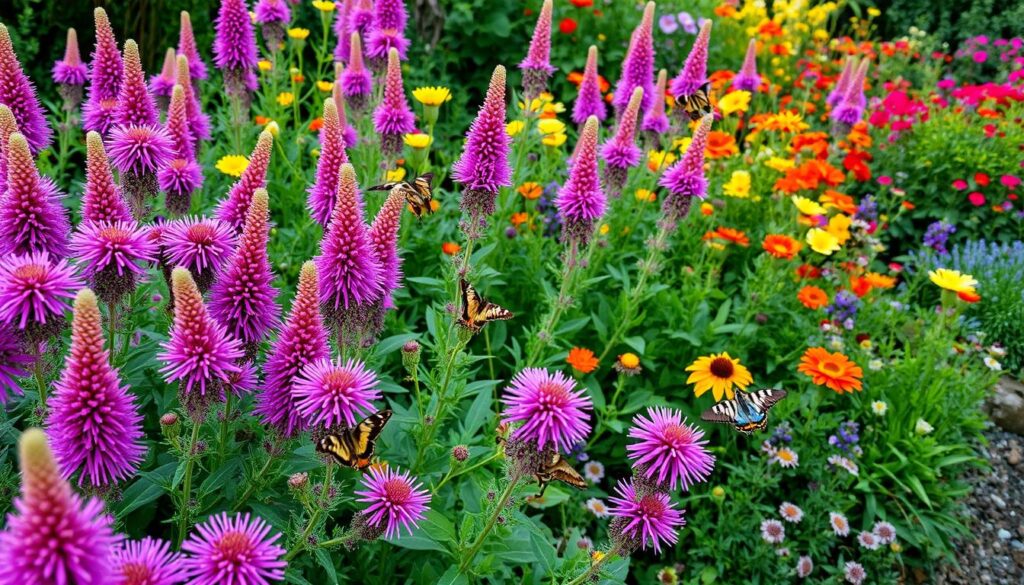
Pollinator Friendly Characteristics
Spirea plants draw in helpful insects. Their flowers offer nectar that pollinators love. Studies show that using spirea in gardens can boost butterfly numbers by 20-30%.
- Attracts honey bees
- Draws native butterflies
- Supports beneficial wasps
- Provides nectar throughout blooming season
Wildlife Attraction Strategies
Placing spirea wisely can turn your garden into a wildlife haven. These shrubs offer shelter and food all year round.
| Wildlife Type | Spirea Benefit |
|---|---|
| Small Birds | Nesting Protection |
| Butterflies | Nectar Source |
| Beneficial Insects | Habitat and Food |
Creating a wildlife-friendly garden isn’t just about looks. It’s about making ecosystems that support local life.
By adding spirea to your garden, you’re doing more than planting shrubs. You’re creating a lively, healthy environment that helps local wildlife and the planet.
Caring for Spirea in Your Landscape
Spirea shrubs are stunning additions to any garden. They offer many options for landscaping. Knowing how to care for them will keep your plants healthy and vibrant.
When adding spirea to your garden, soil matters a lot. These shrubs do best in soil that drains well and has a pH between 6.0 and 7.0.
Soil Requirements
- Choose loamy, rich soil with good drainage
- Avoid heavy clay or waterlogged areas
- Incorporate organic matter to improve soil structure
Watering Strategies
Watering spirea right is key. Young plants need more water, but older ones can handle drought better.
| Plant Age | Watering Frequency | Water Amount |
|---|---|---|
| Young Plants | 2-3 times per week | 1-2 inches of water |
| Established Plants | Weekly during dry periods | 1 inch of water |
Pruning for Health and Aesthetics
Pruning keeps spirea shrubs looking good and growing well. For more tips, check out professional gardening resources.
- Prune in late winter or early spring
- Remove dead, damaged, or crossing branches
- Cut back up to one-third of older stems to encourage new growth
Pro tip: Always use clean, sharp pruning tools to prevent disease transmission and ensure clean cuts.
Incorrect Uses to Avoid with Spirea
When you add spirea to your garden, knowing what not to do is key. Some mistakes can harm these plants’ health and beauty. It’s important to steer clear of common errors.
For spirea to thrive, you need to plan and place them wisely. Here are the main mistakes to avoid:
Overcrowding in Planting Beds
Spirea needs enough room to grow well. Planting them too close together can cause problems:
- Less air gets through
- Diseases spread easier
- They fight for food
- They grow poorly and don’t bloom well
Planting in Inadequate Soil
Good soil is essential for spirea’s health. Bad soil can really hurt their growth.
| Soil Condition | Impact on Spirea |
|---|---|
| Heavy Clay | Poor drainage, root rot |
| Highly Acidic Soil | Nutrient absorption issues |
| Sandy Soil | Insufficient water retention |
Ignoring Sunlight Needs
Sunlight is crucial for spirea. Wrong light can make them weak and reduce blooms. Most spirea likes full sun to partial shade, needing at least 6 hours of sun a day.
“Understanding your plant’s specific requirements is the key to a successful landscape design.” – Garden Experts
Avoiding these mistakes will make your spirea a beautiful part of your landscape design. With careful planning and attention, your spirea will bloom beautifully.
Companion Planting with Spirea
Spirea in landscaping is great for making beautiful garden designs. By choosing the right plants to go with it, your garden will look better and be healthier.
When you’re planning your spirea garden, pick plants that match its growth and looks. The right friends for your spirea can make your garden lively and interesting.
Ideal Neighbors for Spirea
Choosing the right plants for your spirea makes your garden work well together. Here are some great choices:
- Lavender – provides contrasting texture and color
- Ornamental grasses – add vertical interest
- Coneflowers – attract pollinators
- Daylilies – create complementary bloom sequences
- Hostas – offer shade-loving ground cover
Designing Mixed Plantings for Variety
Creating a mix of plants needs careful thought. Consider these things:
| Planting Consideration | Recommendation |
|---|---|
| Bloom Timing | Mix early and late-blooming plants |
| Foliage Texture | Combine fine and coarse leaf structures |
| Height Variation | Layer plants from ground cover to tall shrubs |
“A well-designed garden is like a living painting, with each plant playing a unique role in the composition.” – Garden Design Expert
By picking the right spirea friends, you can make a garden that’s interesting all year. It will also help local wildlife.
Conclusion: Transform Your Landscape with Spirea
Spirea shrubs do more than just decorate gardens. They offer a great way to improve your landscape with little effort. This article has shown how spirea can change outdoor spaces with its beauty and flexibility.
Knowing what makes spirea special helps you make gardens that stand out all year. They’re perfect for easy care or attracting pollinators, fitting many garden styles and places.
Recap of Spirea’s Benefits
Spirea is a smart choice for gardeners wanting beauty and function. These shrubs add variety, attract wildlife, and adapt well. They turn simple outdoor areas into beautiful green spaces.
Encouragement to Try Spirea in Your Garden
Introduce spirea to unlock your landscape’s potential. With many types and easy care, they make creating beautiful gardens easy. Let spirea bring color, texture, and life to your outdoor space.
FAQ
What exactly is a spirea shrub?
Spirea is a type of deciduous shrub from the Rosaceae family. It’s known for its beautiful flowers and leaves. It comes in different sizes and shapes, from small ground covers to tall ornamental shrubs. It’s loved in landscaping for being easy to care for and looking great.
How many varieties of spirea are typically used in landscaping?
There are many spirea types, but three top picks for landscaping are Japanese Spirea, Meadowsweet, and Bumald Spirea. Each has its own flower colors, growth patterns, and uses in the garden.
What are the best landscaping uses for spirea?
Spirea is very flexible in landscaping. It works well for low hedges, big groupings, borders, ground covers, and as highlights in garden designs. It fits both formal and natural garden styles, adding beauty and function.
How much sunlight do spirea shrubs require?
Most spirea types do best in full sun to partial shade. They need at least 6 hours of direct sunlight a day. Too little light can make them grow tall and not bloom as much. Pick a spot that gets enough sunlight for the best health and looks.
Are spirea plants attractive to wildlife?
Yes, spirea is great for wildlife gardens. Its flowers attract bees and butterflies, and its dense shape offers shelter and nesting spots for birds. Adding spirea to your garden helps support local wildlife.
How do I care for spirea shrubs?
Caring for spirea is easy. Make sure the soil drains well, water it when it’s new, and prune it every year to keep it looking good. Most types are tough and can handle different soils, making them good for both new and experienced gardeners.
Can spirea be used in small garden spaces?
Absolutely! Compact types like Bumald Spirea are perfect for small gardens, pots, and city spaces. They have lovely flowers and leaves without taking up too much room, making them great for small areas.
What season provides the most interest with spirea?
Spirea is interesting all year. In spring, it blooms in many colors. Summer keeps its green leaves, fall shows off autumn colors, and winter’s branch structure adds interest. So, spirea is a plant that looks good all seasons.
How do I propagate spirea?
You can grow spirea from hardwood cuttings in winter. Choose healthy branches, cut them to the right length, and follow the right steps to root them. This way, you can grow more spirea without spending extra money.
What are common mistakes to avoid when planting spirea?
Don’t overcrowd spirea in beds, as it can cause poor growth and fewer flowers. Make sure the soil is right, it gets enough sunlight, and plants are far enough apart. Planting and caring for spirea correctly will help it thrive and stay beautiful.


